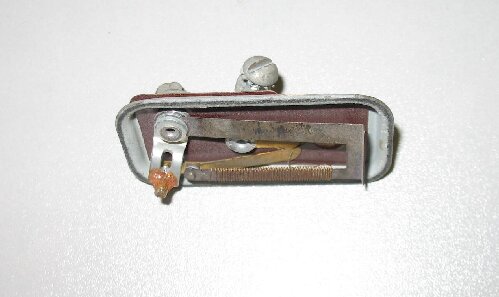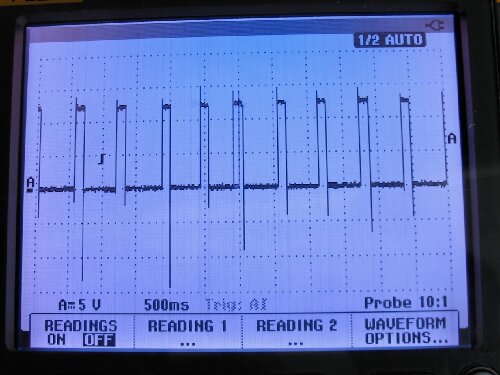|
Re: 56 Packard 400 Dash gauge volt regulator
|
||||
|---|---|---|---|---|
|
Forum Ambassador
|
The gauges should start to move as soon as you turn the key on but they are the thermal type so will take a few seconds to stabilize at the correct reading. If you bought a new regulator of the original type it needs to have a good ground at the back of the cluster before it will work. A volt meter should see an average of 5v at the gauge terminals but since the regulator action is on/off with 12v pulses an ordinary home type meter may not be fast enough or capable of giving an averaged volt reading.
Here is what the original type regulator looks like inside and what the output to the gauges would be as viewed on an oscilloscope. Ground is the heavy line in the middle, the 12v pulses are at the top of the screen and the lines below the screen are common when regular contacts open and close. That is what is typically called noise. It does not affect components of that era but unless the output has some extra work done to it would raise all kinds of problems if a modern solid state component or device tried to use the output of the regulator for anything.  
Posted on: 2024/9/18 11:07
|
|||
|
Howard
|
||||
|
||||
|
Re: 56 Packard 400 Dash gauge volt regulator
|
||||
|---|---|---|---|---|
|
Quite a regular
|
OK, I'm back at these gauges! I made and installed a new Gas, Fuel, Oil power wire and I also checked all three gauges and they are receiving 5volts. The only gauge that seems to work is the fuel gauge because I just put $20 of gas in. I retested the water gauge by grounding the wire and the gauge needle went up, so that confirms the dash gauge is working. I'm back to thinking the water and oil senders are bad. My friend suggests I attach a small battery to the sending unit wire and see if it makes the gauge needle react. So I'm back to thinking the China replace sending units are bad. Any other suggestions on what to do?
Posted on: 1/7 9:46
|
|||
|
||||
|
Re: 56 Packard 400 Dash gauge volt regulator
|
||||
|---|---|---|---|---|
|
Home away from home
|
Certainly the senders could be bad. But they also need to be the correct ohm range. I believe the Ford senders of the era are a correct replacement. The ohm range is listed in the parts book as well.
Posted on: 1/7 10:30
|
|||
|
1955 400 | Registry | Project Blog
1955 Clipper Deluxe | Registry | Project Blog 1955 Clipper Super Panama | Registry Email (Parts/service inquiries only, please. Post all questions on the forum.) service@ultramatic.info |
||||
|
||||
|
Re: 56 Packard 400 Dash gauge volt regulator
|
||||
|---|---|---|---|---|
|
Forum Ambassador
|
The senders need a good ground to complete the electrical path for the wire to the gauge with the temp or pressure varying the resistance values in the sender in order to change the reading. Since the needles move when you manually ground the wire directly I think you have pinpointed the problem as somewhere in the senders or their ground. Sometimes using Teflon tape or some kind of sealant on the sender threads has messed up the connection to ground so check for that possibility.
I don't quite follow the reasoning behind what your friend is asking you to do with the battery but adding more voltage in the circuit might not be a good thing and could damage the gauge. Without knowing what senders you have don't rule out the possibility someone in the past has installed idiot light senders in place of gauge type senders or even gauge senders but with the wrong resistance values. . Senders can look very much alike but work on completely different principles. There is no easy way to check the oil sender resistance values other than start the engine and use an ohmmeter to see if the resistance value with the engine running is somewhere between 70 ohms ( L end ) and 10 ohms which should place the needle at H. On the temp gauge you could use a pan of water at various temps. I don't have a 55-6 chart with gauge deflection but another poster did a check on his 52 which uses a sender in the same ohm range. Here is what he found. Note that the reading is very high when cold but in the expected working temperature ranges his sender also fell into the 70-10 ohm range. 
Posted on: 1/7 10:33
|
|||
|
Howard
|
||||
|
||||








